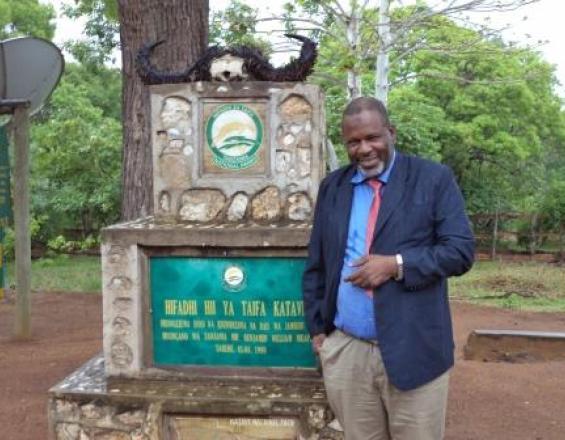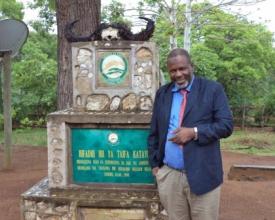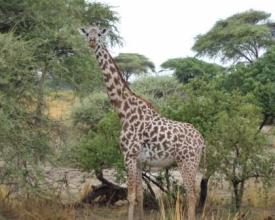
Integrating climate change aspects in protected areas management planning in Tanzania

This solution focuses on the integration of climate change aspects into the overall management plan of Katavi National Park (Tanzania). It serves as a tool available to protected area managers for addressing the impacts of climate change on park biodiversity and ecosystems and adjacent communities; and for building park managers' technical capacity on climate change issues.
Contexte
Challenges addressed
The challenges addressed are both technical and social:
- Lack of recognition of the role of protected areas in achieving adaptation and mitigation goals by key actors
- Limited access to climate and biodiversity data for conservation and development planning
- Technical capabilities: low technical capacity to integrate climate change considerations into protected area management planning
Emplacement
Traiter
Summary of the process
The six building blocks are closely related.
Capacity building on climate change resilience (BB1): Improved stakeholder capacity clearly enhanced their participation in the assessment of climate change vulnerability and land use (BB2), development of climate change strategy (BB 3), revision of the GMP
(BB 4) and communication of the revised GMP (BB 5)
Likewise, knowledge and skills gained, and information generated, during the assessment of land use and climate change vulnerability (BB2) is critical for the review of the GMP (BB 3) and the development of the climate change strategy (BB 4). The review of the GMP (BB 3) and the development of the park climate change strategy (BB 4) contributes to improved capacity on climate change resilience (BB 1) and consequently ehanced skills on the asessment of vulnerability and land use (BB 2 ).
Communication of the park climate change strategy (BB 5) contributes to better capacity on park climate resilience (BB 1), climate change vulnerability and land use asssessment (BB 2), development of a park climate change strategy (BB 4) and also revision of the GMP (BB 3).
Building Blocks
Capacity building on climate change resilience
The purpose of this block is to build capacity of park managers on climate change through workshops focusing on topics that are very specific to climate change issues encountered at the park level.
A series of capacity building workshops were held in Mpanda and Sumbawanga in 2017 to raise awareness on key concepts related to climate change including impacts, vulnerability and resilience in relation to protected areas. The workshops were attended by delegates from Katavi National Park, Lwafi Game Reserve, Mpanda District Council and conservation NGOs working in Mpanda and Rukwa such as LCMO.
The workshops provided participants with key information and knowledge on climate aspects needed in the next steps of integrating climate change in the Park General Management Plan.
Enabling factors
- Availability of interested, motivated and commited stakeholders
- Effective facilitation approaches and strategies
Lesson learned
- Capacity building should not be an on-off event, rather a continous undertaking aimed at enhancing the capacity of both park managers and stakeholders including local communities living adjacent to protected areas.
- The commitment and increased empowerment of communities is important for the sustainability of the solution.
- Monitoring and evaluation must accompany the process to ensure that awareness and capacity is actually improved
Assessment of climate change vulnerability and land use
The purpose of this block is to assess biodiversity vulnerability to climatic and non-climatic stressors (e.g. land use changes). Assessment is a prerequisite for any action to measure the conservation status of biodiversity and the resilience to climate change. These evaluations also help to better guide the identification of appropriate climate change adaptation interventions.
The assessment of climate change vulnerability and land use was done by touring the park and through desk review. While site visits aimed at obtaining crucial information through observation, desk review was conducted to augment field information. The assessment was led by experts accompanied by park managers, district natural resource experts and elders from the adjacent village who have a better understanding of the park and surrounding areas.
Enabling factors
- Inventory of traditional knowledge on biodiversity and weather / climate change.
- Availability and access to scientific baseline data on biodiversity and climate change.
- Ability to visualize past, present and future status of biodiversity in the context of climatic and non-climatic stressors
Lesson learned
Reviewing existing data on climate change is critical to understanding the past and future trends of climate change at the regional and national level.
Site visits in and around the park helps to provide information on the ground status of land uses and biodiversity / ecosystems. Specifically, direct observation provides information on the threats and challenges facing biodiversity and also on the visible signs of climate induced droughts, floods, etc.
Local communities, particularly villagers who have lived longer near / around the Natioanl Park have a better understanding of local changes on climate and biodiversity. As such capturing this information for validating and complementing global and regional data and developing a vision with communities is critical to designing appropriate adaptation strategies.
Reviewing of the Park General Management Plan to include climate resilience aspects
This block addresses the work of revising the management plan so that it integrates aspects related to climate change resilience.
A stakeholder workshop, facilitated by an exppert, was organised in 2016 to review the park GMP. The workshop was attended by Park Managers including ecologists, conservationists from sorrounding Game Reserves, NGOs and programmes operating in the Katavi-Rukwa ecosystem.
The review identified climate change amongst key threats facing biodiversity. In addition, climate change resilience was included in the list of management objectives aimed at capturing climate change resilience amongst GMP objectives and thus reduce its threat to biodiversity and ecosystem. It was agreed by the Park Management and stakeholders, and this was reflected in the revised GMP, that a detailed park climate change strategy should be developed to better address climate change resilience issues.
Enabling factors
Key enabling factors in this BB include:
- Awareness raising on climate change impacts and adaptation statrategies for protected areas
- Effective facilitation of the GMP review process by stakeholders
- Effective stakeholder participation i the review proces
Lesson learned
To better integrate climate change aspects, it is critical to:
- Review exisiting biodiversity threats to include climate change
- Revise management objects to capture climate change resilience
- The protected areas management planning framework should be revised to include climate change. This would allow for the integration of climate change during the GMP development, rather than the review process
Development of a park climate change strategy
Following the climate change and vulnerability assessment, and review of the GMP to include climate change aspects, a consultant framed draft climate change adaptation objectives and strategies which when implemented would lead to improved park resilience to climate change.
A stakeholder workshop was held in September 2017 in Mpanda to validate and augment the draft climate change adaptation objectives and strategies. The workshop was attended by park managers from Katavi National Park, conservationists from Lwafi Game Reserve, Mpanda District Couuncil officials and representatives from NGOs operating in the Rukwa-Katavi Landscape. Inputs provided by stakeholders was used to further develop the adaptation objectives and strategies into a park climate change strategy which details the strategy's goal and objectives, adaptation strategies as well as implementation and monitoring plans. The latter describes a list of key indicators and parameters for monitoring changes in vulnerability and resilience.
Another workshop was held in October 2017 in Sumbawanga to validate the climate change strategy. The workshop was attended by the same group of stakeholder who participated in the other workshop. The final park climate change strategy was to be integrated into & annexed to the GMP.
Enabling factors
- Participation of stakeholders with knowledge on climate change variability and change and biodiversity
- Facilitation by a climate change and natural resource expert
- Access to updated climate (and biodiversity) information
Lesson learned
- Stakeholder participation is key to designing appropriate adaptation measures with the potential of improving resilience to climate change. Thus, stakeholders, including communities adjacent to protected areas, should be involved in the identification and validation of climate change adaptation and mitigation measures.
- The identification of relevant adaptation and mitigation measures requires that the process if facilitated by a qualified climate change expert with a good understand of the regional, national and local context.
- The availability of up to date baseline data, both scientific and indigenous, on climate change aspects informs the designing of relevant adaptation measures
Communicating the Park climate change strategy to stakeholders
The purpose of this block is to raise the awareness of the climate change strategy on a large scale through communication by means adapted especially to the realities of the park area. The media to use depends on the level of intervention. For example, community radio and posters can be used to educate local people; online platforms are useful for a wide audience at the national and international level; and brochures are useful for visitors etc.
Enabling factors
Appropriate communication strategies for example taking into account the literacy levels, linguistic knowledge and other socio-cultural factors.
Lesson learned
- Communicating the climate change strategy ensures that stakeholders are aware of the climate change aspects and that their interest is generated and their commitment is secured to participate in the implementation and respect of the strategy and GMP as a Park Management tool.
- Communicating the climate change strategy will enable stakeholders to provide feedback, via mornitoring and evaluation, on the effective of the strategy in delivering the intended resilience objectives.
Impacts
The positive impacts of the solution are both social and environmental as it allowed park managers:
- To better understand the impacts of climate change on social and ecological systems and the vulnerability of biodiversity and ecosystems.
- To identify priority strategies for adaptation and mitigation of parks.
- To appreciate the role that protected areas can play in supporting the adaptation of nature and local communities by maintaining the flow of ecosystem services and mitigating the impacts of climate change by sequestering carbon.
Beneficiaries
Beneficiaries of this solution include:
- Planners and conservation managers from Katavi National Park and the Tanzania National Parks Authority
- Conservationists working in / around the Rukwa - Katavi Ecosystem



